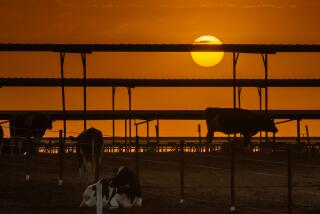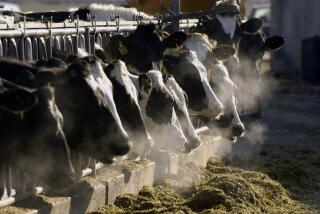Homes on the Range : Developers Pushing Ranchers Out
For years, Ventura County’s cows have fended off natural predators with hoofs and horns. But no cow in its right mind wants to charge a suburban shopping mall.
So, as development marches inexorably into the canyons, plains and ranges of Ventura County, cows and their owners are pulling up stakes and moving to greener pastures.
Remote Sites
In less than 20 years, the beef cattle herd has dropped by two-thirds and the county’s three feedlots have closed. Today, most of the remaining 16,500 cattle are raised by a handful of ranchers in remote hills fringing Simi Valley and all-but-inaccessible grazing lands near Santa Paula, Piru and Fillmore.
“You keep getting pushed further back,” said Stephen Percy, a tall, lean, fourth-generation rancher who talks in slow, careful cadences worthy of John Wayne. Percy and his 30-year-old son Jim lease most of Big Sky Ranch in Simi Valley and raise 1,100 head of beef cattle on its 9,400 acres.
“I could run cattle on here for 40 years and turn it over to my son,” Percy said. “But a developer comes in, pours a bunch of concrete and builds a bunch of houses. Then he has to find someplace else to ruin.”
Not surprisingly, developers see things differently.
“People need houses to live in. That’s the American dream, to own your own house, and I don’t think there’s anything wrong with providing the American dream,” said Glen Gessford, president of Big Sky Development Co., which owns Big Sky Ranch.
In recent decades, this scenario of cows vs. condos has flickered like a bad Western across the once-open California ranges as ranchers shut down their operations and allied businesses like feedlots move to states like Kansas, Colorado and Nebraska, which offer cheaper land, grain and transportation costs.
Economic Change
Since 1973, California’s feed yards have dwindled from 175 to 65; the number of cattle in those yards has plunged from 1 million to 500,000, and the number of cattle-slaughtering plants has dropped from 100 to 20, according to the California Cattle Feeders Assn.
“Thousands of cattlemen in California and nationwide are threatened by economic change and a shift in the American palate away from red meat,” said Chuck Levitt, a livestock market analyst for Shearson Lehman Hutton in Chicago.
Ranchers in Ventura County are no exception. Big Sky’s Gessford says the Percys will lose almost one-third of their grazing lands if the company succeeds in a plan to develop 2,700 acres of the cattle ranch with 2,080 homes and a neighborhood shopping center. Big Sky is now negotiating with Simi Valley planning officials for the needed zoning changes.
“The economic realities of life are that there’s not much profit and not much wages in beef cattle in Ventura County,” Gessford said.
Cattlemen agree. Today, the county’s annual beef cattle sales account for only $3 million. By contrast, the county’s citrus crop, its biggest agricultural revenue-producer, brought in $163 million in 1986.
Cowboy Allure
But then, cattlemen say they’re not in the profession strictly for financial rewards.
Ranchers say the payoff is less tangible, that it involves the lure of the cowboy life style and the chance to be part of the legendary American West. They talk about the harsh satisfaction that comes from doctoring an ailing calf before dawn, of being master of one’s destiny, of riding on horseback across rolling green ranges with only the wind and an occasional bleating calf for company.
In short, most ranchers wouldn’t be happy anywhere else.
“I don’t make much money, but it’s a good life,” said Bo Ramsey, who runs a herd of 250 beef cattle on the Canada Larga Ranch between Ojai and Ventura. “You see your cows get better and weigh more each year. You’re out here with nature, and there’s nobody around to hassle you. . . . It’s a little hard to explain to a city person,” he said.
Indeed, the lure of the Western life style has in recent years attracted a new breed of cowboy. These are gentlemen ranchers, men who work full-time at other professions and run a few cows on the side.
Ventura County agriculture officials don’t keep tabs on their numbers, but one part-time rancher says he knows of six men in the Ojai Valley alone who keep between 15 and 80 head of cattle each.
Norm Davis, who owns the Ojai Valley Feed store, earned his cowboy credentials two years ago when he and some partners began putting together a cow-calf operation--the term for beef cows that produce calves for sale to feedlots. Now they have about 16 head.
‘Really Relaxing’
“It’s a sideline, . . . something I like to do,” Davis says. “When I get home from work, it’s just really relaxing for me to go out and spend some time with the animals. If I can make a little money on it, terrific.”
But for many of the old-time cattle-ranching families, the only other source of money is the land itself, and there are only three ways to tap it: develop, diversify or divest.
Newhall Land & Farming, one of California’s 10 top landowners, long ago chose to develop. The giant company, which still holds some grazing areas in Ventura County, shifted its emphasis from cattle to condos and 20 years ago started building the community of Valencia, its home base, 35 miles north of downtown Los Angeles in the Santa Clarita Valley.
The 7,000-acre Smith-Hobson Ranch between Ventura and Santa Paula diversified into citrus back in 1964 and now harvests lemons and oranges on 200 acres. Manager Greg Smith still runs 500 head of Hereford and Hereford/Angus cattle there but says the orchards are the real cash cows.
Then there’s Bruce Strathearn, whose family began cattle ranching in 1885. Strathearn sold his 12,000-acre Moorpark ranch in the early 1960s and donated some of the land to Moorpark College. Even when Moorpark was a lot more rural than it is today, it was getting too citified for the pioneer ranchers.
“We didn’t like the motorcycles and the cut fences so we quit,” says Strathearn, who formerly ran about 1,000 head of cattle.
A number of ranchers have been done in by rising property taxes and a dwindling beef market as health-conscious consumers turn increasingly to poultry.
Former rancher Dewey Runkle says his family sold its 2,800-acre Runkle Cattle Ranch in Simi Valley in 1973 because of skyrocketing property taxes and creeping urbanization. Runkle now works for the Ventura County Agricultural Commissioner, and one of his duties is to perform brand inspections on cattle.
“Any rancher will tell you that it’s pretty hard to keep cattle next to cities,” says Runkle, the last of four cattle-ranching generations. As cities spread, land available for grazing dwindles, squeezing out the cows.
Percy’s family once owned a 2,000-acre ranch 12 miles north of Fillmore in what is now part of the Sespe Condor Sanctuary.
There’s a Trade-Off
“My Dad tells of driving cattle down Main Street in Ventura,” recalls Percy, his tan face crinkling into a half-squint, half-smile. The delicate pattern of lines etched across the 53-year-old man’s face bears testament to the hard work that is cattle ranching.
Although he grew up in the business, Percy swore off it and took a job teaching elementary school when his father sold the Fillmore ranch in 1966.
But after one year, “I damn near went crazy,” Percy recalled.
Re-entering the business has soothed his blood but brought him no certain peace. Big Sky keeps him on a one-year lease. He has gone broke three times and has locked horns over the years with developers, drought, cattle rustlers and dirt-bikers. Today, his wife teaches school to supplement the family income and a partner, Morrie Caldwell, bails out the business during lean years.
Life on the ranch follows a cyclical pattern. During the calving season, which runs from mid-September to December, “You practically live with those girls,” Percy says, referring to the need to monitor the cows. A good cow is one that bears a calf annually for 12 or more years, he adds.
In July, the Percys wean the calves, driving them apart from their mothers for several days until they take to grazing.
From mid-December to the beginning of March, the bulls are let loose with the cows to mate, and the whole process soon begins again.
The Percys raise their Angus/Hereford crossbreed cows for about a year and a half and ship them to auction houses in Stockton in late spring. Depending on weight, the cattle fetch between $300 and $600 each. The heavier animals weigh 800 pounds. The cattle are then shipped to feedlots and fattened for 90 days until they hit 1,100 pounds and are ready for slaughter.
A rancher’s day starts before 5 each morning--and sometimes runs around the clock if a cow is sick. Each animal must be vaccinated and branded, which involves driving them down the mountains and into the corrals.
The Percys drive their cattle onto nearby fields to eat the stubble from safflower harvests, which clears the ground for the next planting.
On a recent day, Percy, in a cowboy shirt, jeans, a bandanna knotted around his neck, a cowboy hat and work boots, gunned the accelerator on a pickup truck and headed up a hill to check on some cows.
High above Simi Valley he climbed, past undulating green hills and clumps of cows that lumbered away at the truck’s approach.
After checking on a broken water pipe--cowboys spend a lot of time repairing fences, keeping out trespassers and checking water levels in the series of tanks that crisscross their lands--Percy headed to Sand Canyon, where a calf with an abscessed leg needed some tending to.
Percy’s son, a registered nurse, soon rode into sight on his horse, herding the wounded calf in front of him with a series of whistles and calls.
The two men penned the calf into a corral and shooed it into a chute that trapped its head and flipped it sideways so the men could inspect the injured leg. The younger Percy probed the wound with the nimbleness of a surgeon, lancing it with a penknife, injecting an antibiotic and applying an ointment.
Ventura isn’t a high-tech agribusiness area--the genetic engineering and video cattle auctions practiced in the Midwest are uncommon here.
Up-to-Date Methods
But Percy and other ranchers reap the profits of biotechnology and advanced breeding techniques nonetheless. There is more cross-breeding today with large European cows, which results in bigger, beefier animals. Today, 90% of the cows bear calves; a generation ago, 70% did.
And ranchers themselves are getting more savvy.
In attempts to combat the flagging image of red meat, cattle promotional groups have launched a $70-million campaign stressing beef’s nutritional value. The National Beef Council has hired actor James Garner as its spokesman.
Nationwide, the cattle herd has dropped from a 1975 peak of 132 million head to about 95 million for 1988, Levitt said.
The drop has caused beef prices to rally in 1987 for the first time in almost a decade. Percy says cautiously that he expects to make a little money this year. Other ranchers hope that beef prices continue to remain strong.
But Percy is already looking ahead to when the Big Sky Development complex will edge him out of Simi.
That development “is going to cut my land way down so that I’m not sure it’s going to be economical to stay here,” he says with a slow, steady voice.
“I just hope I can find another ranch by then.”
More to Read
Sign up for Essential California
The most important California stories and recommendations in your inbox every morning.
You may occasionally receive promotional content from the Los Angeles Times.










